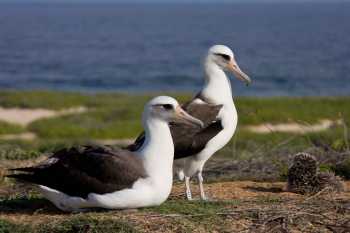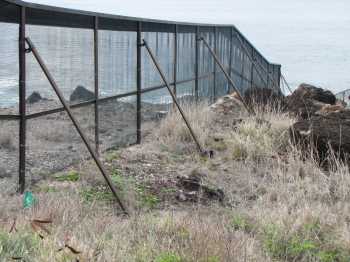In the first post-predator eradication breeding season for Laysan Albatrosses Phoebastria immutabilis on the Hawaiian island of Oahu, reproductive success as well as the total number of chicks produced has risen. This year saw a record 61 nests initiated within the fenced area at the Kaena Point Natural Area Reserve, and a record 30 chicks fledge.
Whereas the fledging success rate was normal, the rise in the number of chicks produced (previous high was 24 in 2010) was assisted by an increase in the hatching rate (69%, compared to 58% prior to fencing and predator removal). In previous years, most of the predation observed was indeed on eggs, typically by the introduced Small Indian Mongoose Herpestes javanicus.

Laysan Albatross pair with their chick at Kaena Point.
Photograph by Lindsay Young

The predator-proof fence protecting the Kaena Point Natural Area Reserve
Photograph by John Cooper
Following the completion of a predator-proof fence in March 2011, all mammalian predators were removed by November 2011 just in time for the Laysan Albatross breeding season. Now that the predators are gone, it is hoped that both fledging, and hatching rates will continue to rise and also that new species of seabirds will begin to colonize the reserve, particularly Black-footed Albatrosses P. nigripes which were present on numerous occasions this year.
Lindsay Young, ACAP North Pacific News Correspondent, 7 July 2012

 English
English  Français
Français  Español
Español